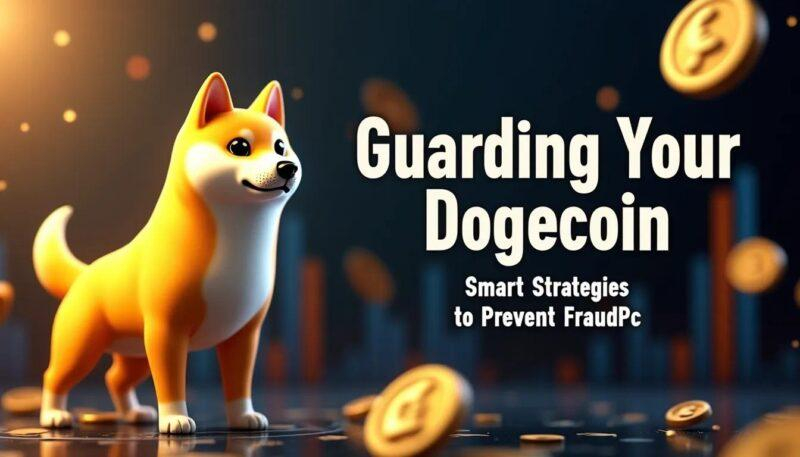In the ever-evolving world of cryptocurrency, Dogecoin has emerged from its origins as a playful meme to become a formidable player in the digital financial landscape. But beneath its whimsical facade lies a complex web of unseen cyber challenges that could impact investors and tech enthusiasts alike. As Dogecoin continues to capture attention with its rapid fluctuations and dedicated community, understanding the hidden cyber risks that accompany this unconventional currency is more crucial than ever. This article sets out to unpack Dogecoin’s digital footprint, shedding light on the potential vulnerabilities and navigating the uncertain terrain ahead.
Understanding Dogecoin’s Popularity and Its Appeal to Cybercriminals
Dogecoin’s meteoric rise from a joke cryptocurrency to a household name can be attributed to its unique blend of community-driven momentum and viral internet culture. Unlike traditional cryptocurrencies that emphasize complex technology or financial utility, Dogecoin thrives on its accessibility and a lighthearted narrative. This has cultivated a loyal, enthusiastic base, including influencers and casual investors who see Dogecoin not just as an asset, but as part of a broader cultural movement.
However, this mainstream appeal has also inadvertently painted a target on Dogecoin’s back within the cybercrime landscape. Its widespread recognition, combined with relatively low transaction costs and fast confirmation times, makes it an attractive vehicle for a variety of nefarious activities. Cybercriminals can exploit these traits to:
- Facilitate anonymous ransomware payments
- Engage in money laundering schemes
- Conduct fraud through phishing scams using Dogecoin giveaways
- Manipulate markets with pump-and-dump tactics
To better understand why Dogecoin stands out among its peers in illicit use, consider the comparison below:
| Cryptocurrency | Transaction Speed | Average Fee | Cybercrime Appeal |
|---|---|---|---|
| Dogecoin | ~1 min | Low (<0.01 USD) | High (due to fast, cheap transfers) |
| Bitcoin | ~10 min | Higher (varies, typically >1 USD) | Moderate (more traceability) |
| Monero | ~2 min | Moderate (~0.03 USD) | Very High (enhanced privacy) |
Examining Common Cyber Threats Targeting Dogecoin Users
Dogecoin’s rise in popularity has unfortunately made it a lucrative target for cybercriminals eager to exploit its community. One prevailing danger is phishing scams, where attackers craft convincing fake websites or messages impersonating official Dogecoin platforms or wallets. These scams often lure users into divulging private keys or login credentials, leading to irreversible loss of funds. As these fraudulent campaigns grow more sophisticated, distinguishing between genuine and fake communications becomes increasingly difficult for casual users.
Another critical risk revolves around malware attacks specifically designed to compromise cryptocurrency wallets. Variants such as keyloggers, clipboard hijackers, and Trojan horses lurk in seemingly harmless downloads or email attachments. Once active, they silently monitor user activity or replace copied wallet addresses with those controlled by hackers, redirecting Dogecoin transfers without the user’s knowledge. In this perilous environment, maintaining stringent cybersecurity hygiene is more crucial than ever.
The decentralized nature of Dogecoin also attracts pump-and-dump schemes and fake initial coin offerings (ICOs) that manipulate market sentiment. Unsuspecting investors might be drawn into these misleading promotions, only to find their investments vaporize overnight. Below is a quick comparison table highlighting common threat types experienced by Dogecoin users:
| Threat | Method | User Impact |
|---|---|---|
| Phishing | Fake websites & emails | Credential theft & fund loss |
| Malware | Keyloggers & clipboard hijackers | Wallet compromise & theft |
| Pump-and-Dump | Market manipulation | Financial loss & false hype |
| Fake ICOs | Fraudulent investment schemes | Lost capital & trust |
The Role of Wallet Security in Protecting Dogecoin Assets
In the dynamic world of cryptocurrency, the sanctity of your Dogecoin holdings hinges largely on the fortress you build around your digital wallet. Wallet security transcends mere password protection; it embodies a multi-layered defense strategy designed to thwart evolving cyber threats. From phishing schemes targeting private keys to sophisticated malware that intercepts transaction data, vulnerabilities in wallet security can lead to irrevocable losses, making robust protection an absolute necessity for every Dogecoin investor.
Key components that fortify your Dogecoin wallet include:
- Hardware wallets: Offline devices that shield private keys from internet-borne threats.
- Multi-factor authentication (MFA): An additional verification layer reducing unauthorized access.
- Encryption: Safeguards sensitive data against interception and tampering.
- Regular software updates: Patch known vulnerabilities and enhance security protocols.
| Security Tactic | Benefit | Risk Mitigated |
|---|---|---|
| Hardware Wallet | Isolates keys | Remote hacking |
| MFA | Confirms user identity | Unauthorized access |
| Encryption | Data confidentiality | Man-in-the-middle attacks |
| Updates | Fixes loopholes | Exploit vulnerabilities |
Ignoring wallet security is akin to leaving the door to your crypto vault wide open. As cybercriminals constantly refine their tactics, staying vigilant and proactive becomes your best defense. Protecting your Dogecoin assets starts with cultivating a deep understanding of wallet vulnerabilities and seamlessly integrating cutting-edge security measures into your daily digital routine. The value of your holdings depends not just on market performance, but on how effectively you can guard the keys to your crypto kingdom.
Strategies for Safe Transactions in a High-Risk Crypto Environment
In the fast-evolving crypto landscape, especially with assets like Dogecoin, vigilance is more than a virtue-it’s a necessity. Start by implementing multi-factor authentication (MFA) across all your crypto exchange accounts. This simple step adds an essential layer of protection by requiring multiple verification forms, drastically reducing unauthorized access risks. Pair this with hardware wallets wherever possible to keep your private keys offline and safe from hackers.
Always scrutinize the platforms you engage with. When choosing exchanges or wallets, prioritize those with strong reputations, transparent security measures, and comprehensive user reviews. Be wary of offers that promise unusually high returns or urgent investment opportunities-these often cloak phishing attempts or scams. Staying educated about common phishing tactics and regularly updating your software defenses are vital continuous habits.
- Verify URLs before entering credentials to avoid fake websites.
- Limit public exposure of your wallet addresses to reduce targeted attacks.
- Keep transaction records for easy auditing and dispute resolution.
| Security Measure | Benefit | Implementation Tip |
|---|---|---|
| Multi-Factor Authentication | Blocks unauthorized logins | Use authenticator apps over SMS |
| Hardware Wallet | Secures private keys offline | Keep device firmware updated |
| Phishing Awareness | Prevents credential theft | Verify sender emails and links |
Future Challenges and Recommendations for Dogecoin Cybersecurity
As Dogecoin continues to carve out its niche in the cryptocurrency landscape, the evolving cyber threat environment demands a proactive stance. The decentralized nature of Dogecoin, while a strength, also exposes it to unique vulnerabilities such as 51% attacks or protocol-level exploits. Ensuring sustained network security means developers and stakeholders must prioritize the hardening of mining pools and validation processes to guard against malicious consolidation of mining power.
On the user front, social engineering and phishing attacks are poised to become more sophisticated, targeting both novice and seasoned holders. Building user-centric education programs and integrating multi-factor authentication mechanisms into wallets could significantly reduce the risk of credential theft. Furthermore, adoption of behavioral analytics on transaction patterns could serve as an early warning system, detecting anomalous activities before they manifest into large-scale breaches.
From a governance perspective, collaboration across the Dogecoin community is paramount to staying ahead of cyber adversaries. Consider the following tactical recommendations for a resilient Dogecoin ecosystem:
- Enhanced protocol audits by independent security firms to uncover latent weaknesses.
- Development of decentralized identity solutions aimed at verifying legitimate participants without compromising privacy.
- Investment in real-time threat intelligence sharing among blockchain networks to preempt cross-chain exploits.
| Challenge | Potential Impact | Recommended Action |
|---|---|---|
| Mining Pool Centralization | Network Vulnerability | Enforce distribution protocols |
| Phishing Attacks | Funds Loss | Strengthen user education |
| Cross-Chain Exploits | Security Breaches | Implement threat intelligence sharing |
Q&A
Unpacking Dogecoin: Navigating the Hidden Cyber Risks Ahead – Q&A
Q1: What exactly is Dogecoin, and why has it captured so much attention?
A1: Dogecoin started in 2013 as a lighthearted, meme-inspired cryptocurrency featuring the Shiba Inu dog from the “Doge” meme. What began as a joke quickly gained traction for its active community and easy accessibility. Today, it’s more than fluff-it’s a digital asset with real market value, used for tipping, microtransactions, and even philanthropy. Its surge in popularity, partly fueled by celebrity endorsements and social media buzz, has thrust it into the spotlight-alongside a growing landscape of cyber risks.
Q2: Why should we be concerned about cyber risks specifically with Dogecoin?
A2: Like all cryptocurrencies, Dogecoin operates on blockchain technology, which promises transparency and security. However, it’s not immune to cyber threats. Because Dogecoin became popular fast, many users entered the space without strong cybersecurity practices. This makes them prime targets for scams, phishing attacks, and hacking attempts. Plus, the decentralized and pseudonymous nature of Dogecoin transactions can inadvertently aid cybercriminals in laundering funds or conducting fraud unnoticed.
Q3: What are some common cyber risks associated with Dogecoin?
A3: Some lurking risks include:
- Phishing Scams: Fake websites or messages tricking users into revealing private keys or wallet passwords.
- Fake Wallets and Apps: Malicious software posing as legitimate Dogecoin wallets to steal funds.
- Pump-and-Dump Schemes: Coordinated efforts to inflate Dogecoin’s price artificially before dumping it, leaving investors with losses.
- Exchange Vulnerabilities: Hacks on trading platforms where Dogecoin is bought or sold.
- Ransomware Demands: Cybercriminals demanding Dogecoin as ransom, exploiting its popularity and relative anonymity.
Q4: How can Dogecoin users protect themselves from these cyber threats?
A4: Vigilance is key. Users should:
- Use reputable wallets and exchanges with strong security protocols.
- Enable two-factor authentication wherever possible.
- Never share private keys or seed phrases.
- Double-check URLs and beware of unsolicited requests for information.
- Stay informed about common scams and new threat trends.
- Consider cold storage (offline wallets) for holding large amounts.
Q5: Does Dogecoin’s community play a role in managing cyber risks?
A5: Absolutely. The Dogecoin community is known for its grassroots spirit and can be a valuable resource in identifying and exposing scams. Community forums, social media groups, and dedicated watchdog channels often share timely warnings and education to keep members alert. However, because the community is decentralized, there’s no formal governing body to enforce security-making personal responsibility essential.
Q6: How might emerging technologies affect Dogecoin’s cyber risk landscape in the future?
A6: Advances like quantum computing could challenge current cryptographic protections in blockchains, posing potential risks to Dogecoin’s security framework. Simultaneously, improvements in AI-driven threat detection and blockchain analytics might boost defenses against fraud and theft. Staying ahead of these tech shifts will be critical for minimizing vulnerabilities and ensuring Dogecoin remains a safe digital currency option.
Q7: In one sentence, what’s the essential takeaway for anyone involved with Dogecoin?
A7: Embrace Dogecoin’s revolutionary spirit-but navigate its cyber risks with informed caution, rigorous security habits, and a healthy dose of skepticism.
In Conclusion
As Dogecoin continues to capture the imagination of investors and internet communities alike, its glittering rise is shadowed by an often-overlooked tapestry of cyber risks. Navigating this digital terrain requires more than just enthusiasm-it demands vigilance, informed awareness, and a keen eye on evolving threats. While the meme-inspired cryptocurrency rides the waves of popularity, understanding the hidden vulnerabilities beneath the surface is essential for anyone looking to engage safely with this digital asset. In the ever-shifting landscape of crypto, unpacking Dogecoin’s allure means also unpacking the caution required to stay one step ahead in a space where innovation and risk are inseparably intertwined.







